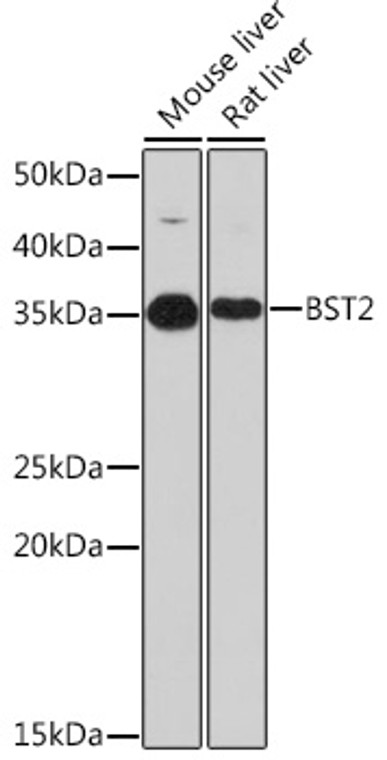| Host: |
Rabbit |
| Applications: |
WB |
| Reactivity: |
Mouse/Rat |
| Note: |
STRICTLY FOR FURTHER SCIENTIFIC RESEARCH USE ONLY (RUO). MUST NOT TO BE USED IN DIAGNOSTIC OR THERAPEUTIC APPLICATIONS. |
| Short Description: |
Rabbit monoclonal antibody anti-BST2 (70-150) is suitable for use in Western Blot research applications. |
| Clonality: |
Monoclonal |
| Clone ID: |
S4MR |
| Conjugation: |
Unconjugated |
| Isotype: |
IgG |
| Formulation: |
PBS with 0.05% Proclin300, 0.05% BSA, 50% Glycerol, pH7.3. |
| Purification: |
Affinity purification |
| Dilution Range: |
WB 1:500-1:1000 |
| Storage Instruction: |
Store at-20°C for up to 1 year from the date of receipt, and avoid repeat freeze-thaw cycles. |
| Gene Symbol: |
BST2 |
| Gene ID: |
684 |
| Uniprot ID: |
BST2_HUMAN |
| Immunogen Region: |
70-150 |
| Immunogen: |
A synthetic peptide corresponding to a sequence within amino acids 70-150 of human BST2 (Q10589). |
| Immunogen Sequence: |
LQQELTEAQKGFQDVEAQAA TCNHTVMALMASLDAEKAQG QKKVEELEGEITTLNHKLQD ASAEVERLRRENQVLSVRIA D |
| Tissue Specificity | Predominantly expressed in liver, lung, heart and placenta. Lower levels in pancreas, kidney, skeletal muscle and brain. Overexpressed in multiple myeloma cells. Highly expressed during B-cell development, from pro-B precursors to plasma cells. Highly expressed on T-cells, monocytes, NK cells and dendritic cells (at protein level). |
| Post Translational Modifications | Monoubiquitinated by KSHV E3 ubiquitin-protein ligase K5, leading to its targeting to late endosomes and degradation. The GPI anchor is essential for its antiviral activity. |
| Function | IFN-induced antiviral host restriction factor which efficiently blocks the release of diverse mammalian enveloped viruses by directly tethering nascent virions to the membranes of infected cells. Acts as a direct physical tether, holding virions to the cell membrane and linking virions to each other. The tethered virions can be internalized by endocytosis and subsequently degraded or they can remain on the cell surface. In either case, their spread as cell-free virions is restricted. Its target viruses belong to diverse families, including retroviridae: human immunodeficiency virus type 1 (HIV-1), human immunodeficiency virus type 2 (HIV-2), simian immunodeficiency viruses (SIVs), equine infectious anemia virus (EIAV), feline immunodeficiency virus (FIV), prototype foamy virus (PFV), Mason-Pfizer monkey virus (MPMV), human T-cell leukemia virus type 1 (HTLV-1), Rous sarcoma virus (RSV) and murine leukemia virus (MLV), flavivirideae: hepatitis C virus (HCV), filoviridae: ebola virus (EBOV) and marburg virus (MARV), arenaviridae: lassa virus (LASV) and machupo virus (MACV), herpesviridae: kaposis sarcoma-associated herpesvirus (KSHV), rhabdoviridae: vesicular stomatitis virus (VSV), orthomyxoviridae: influenza A virus, paramyxoviridae: nipah virus, and coronaviridae: SARS-CoV. Can inhibit cell surface proteolytic activity of MMP14 causing decreased activation of MMP15 which results in inhibition of cell growth and migration. Can stimulate signaling by LILRA4/ILT7 and consequently provide negative feedback to the production of IFN by plasmacytoid dendritic cells in response to viral infection. Plays a role in the organization of the subapical actin cytoskeleton in polarized epithelial cells. Isoform 1 and isoform 2 are both effective viral restriction factors but have differing antiviral and signaling activities. Isoform 2 is resistant to HIV-1 Vpu-mediated degradation and restricts HIV-1 viral budding in the presence of Vpu. Isoform 1 acts as an activator of NF-kappa-B and this activity is inhibited by isoform 2. |
| Protein Name | Bone Marrow Stromal Antigen 2Bst-2Hm1.24 AntigenTetherinCd Antigen Cd317 |
| Database Links | Reactome: R-HSA-6798695Reactome: R-HSA-909733Reactome: R-HSA-9692916 |
| Cellular Localisation | Golgi ApparatusTrans-Golgi NetworkCell MembraneSingle-Pass Type Ii Membrane ProteinLipid-AnchorGpi-AnchorMembrane RaftCytoplasmApical Cell MembraneShuttles Between The Cell MembraneWhere It Is Present Predominantly In Membrane/Lipid RaftsAnd The Trans-Golgi NetworkForms A Complex With Mmp14 And Localizes To The CytoplasmLate Endosome(Microbial Infection) Hiv-1 Vpu And Hiv-2 Env Can Target It To The Trans-Golgi Network Thus Sequestering It Away From Virus Assembly Sites On The Cell MembraneTargeted To Late Endosomes Upon Kshv Infection And Subsequent Ubiquitination |
| Alternative Antibody Names | Anti-Bone Marrow Stromal Antigen 2 antibodyAnti-Bst-2 antibodyAnti-Hm1.24 Antigen antibodyAnti-Tetherin antibodyAnti-Cd Antigen Cd317 antibodyAnti-BST2 antibody |
Information sourced from Uniprot.org
12 months for antibodies. 6 months for ELISA Kits. Please see website T&Cs for further guidance








